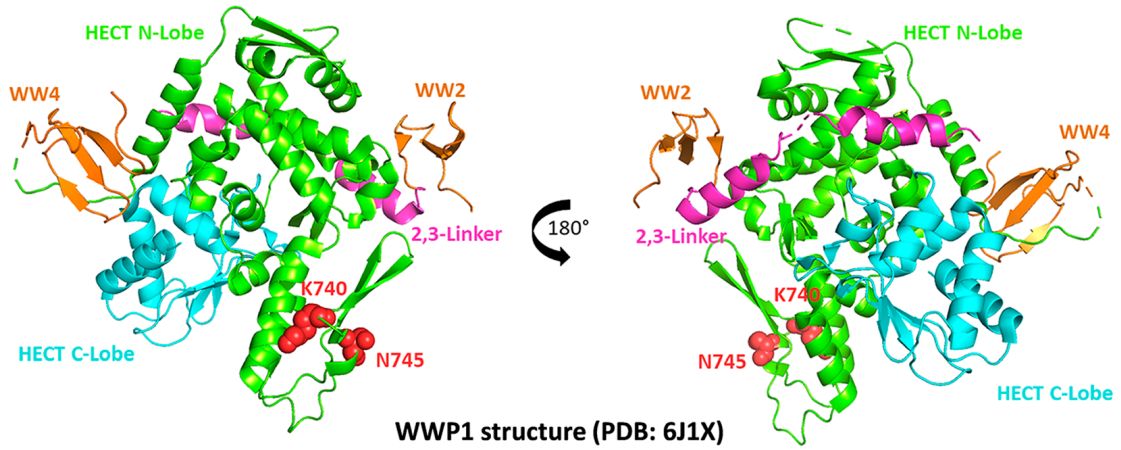What is WWP1 Protein
What is WWP1 Protein?
The WWP1 protein, a member of the ubiquitin ligase family, possesses distinct WW domains that confer it with the ability to interact with specific protein sequences. Ubiquitin ligases, including WWP1, are integral components of the cellular machinery, orchestrating the ubiquitination of proteins for subsequent degradation, a fundamental process in maintaining cellular homeostasis.

Figure 1. Crystal structure of WWP1 with the autoinhibitory 2,3-linker. (Jiang, H., et al. 2021)
The Function of WWP1 Protein
At its core, WWP1 operates as an E3 ubiquitin ligase, orchestrating the transfer of ubiquitin molecules onto target proteins. This process serves as a molecular tag, marking proteins for degradation within the proteasome. The ramifications of WWP1's actions extend to the regulation of diverse cellular processes, including cell proliferation, apoptosis, and signal transduction pathways.
The significance of WWP1 in cellular regulation is underscored by its capacity to modulate the stability of critical regulatory proteins. By fine-tuning the levels of specific proteins, WWP1 assumes a central role in ensuring the proper functioning of cellular processes.
WWP1-Related Diseases
- Cancer
The dysregulation of WWP1 has been prominently linked to cancer. Overexpression of WWP1 in certain tumors has been observed, with profound implications for cellular dynamics. WWP1, by promoting the degradation of tumor suppressors or regulators of cell growth, engenders an environment conducive to uncontrolled cell proliferation and tumorigenesis.
- Neurological Disorders
Recent research posits a potential association between WWP1 and neurological disorders. The protein's involvement in the regulation of apoptosis and neuroinflammation positions it as a candidate of interest in conditions like Alzheimer's disease and Parkinson's disease.
- Immune System Disorders
WWP1's influence extends to the immune system, where dysregulation may contribute to autoimmune diseases or compromise the immune response against pathogens. The intricate interplay between WWP1 and immune regulatory pathways merits further exploration in understanding and potentially treating immune-related disorders.
WWP1 Related Signaling Pathways
- Wnt Signaling Pathway
WWP1 exerts regulatory control over the Wnt signaling pathway by targeting key components for ubiquitin-mediated degradation. This interaction intricately influences cell fate decisions, cell proliferation, and overall tissue homeostasis, showcasing the depth of WWP1's involvement in cellular signaling cascades.
- TGF-β Signaling Pathway
In the context of the TGF-β signaling pathway, WWP1's ubiquitin ligase activity modulates the stability of proteins within the pathway. This regulation contributes to the fine-tuning of cellular responses to TGF-β, underscoring WWP1's versatility in influencing diverse signaling pathways.
- Notch Signaling Pathway
The Notch signaling pathway, critical for cell fate determination and tissue development, falls under the purview of WWP1 regulation. Through ubiquitination, WWP1 impacts the turnover of key components within the Notch pathway, thereby influencing cellular differentiation processes.
Applications of WWP1 in Biomedical Research
- Diagnostic Biomarker
WWP1's expression levels hold potential as diagnostic biomarkers, particularly in cancer. Detection of aberrant WWP1 expression in tissues or biofluids could serve as an indicator for early disease diagnosis and prognosis.
- Drug Target
Given its involvement in various diseases, WWP1 emerges as a promising drug target. The development of compounds that modulate WWP1 activity opens avenues for therapeutic interventions, especially in conditions where WWP1 dysregulation is a contributing factor.
- Therapeutic Interventions
Manipulating WWP1 activity presents a promising avenue for therapeutic interventions. Targeting WWP1 in specific diseases, such as cancer, holds the potential to curb uncontrolled cell proliferation and promote apoptosis, offering novel approaches to disease treatment.
- Biomedical Research Tool
WWP1's role in ubiquitination and protein degradation positions it as a valuable tool for biomedical research. Researchers can leverage WWP1 as a molecular probe to unravel intricate cellular processes, providing nuanced insights into signaling pathways and protein interactions in various cellular contexts.
In the intricate web of cellular regulation, the WWP1 protein emerges as a multifaceted orchestrator, influencing fundamental processes ranging from cell proliferation to immune responses. As research in this domain continues to burgeon, WWP1 stands as a testament to the complex interplay between proteins and cellular dynamics, paving the way for innovative strides in biological and medical sciences.
Recommended Products for WWP1 Protein
| Cat.# | Species | Product name | Source (Host) | Tag |
|---|---|---|---|---|
| WWP1-75H | Human | Recombinant Human WWP1, GST-tagged | Sf9 Insect Cell | GST |
| WWP1-31531TH | Human | Recombinant Human WWP1, FLAG-tagged | Insect Cell | Flag |
| WWP1-477H | Human | Recombinant Human WWP1, GST-tagged | Sf9 Insect Cell | Flag |
| WWP1-5224R | Rhesus Macaque | Recombinant Rhesus monkey WWP1 Protein, His-tagged | Mammalian Cell | His |
| WWP1-5037R | Rhesus Macaque | Recombinant Rhesus Macaque WWP1 Protein, His (Fc)-Avi-tagged | HEK293 | His (Fc)-Avi |
| WWP1-1926C | Chicken | Recombinant Chicken WWP1 | Mammalian Cell | His |
Reference
- Jiang, H., et al. Ubiquitin Ligase Activities of WWP1 Germline Variants K740N and N745S. Biochemistry. 2021, 60(5): 357-364.

